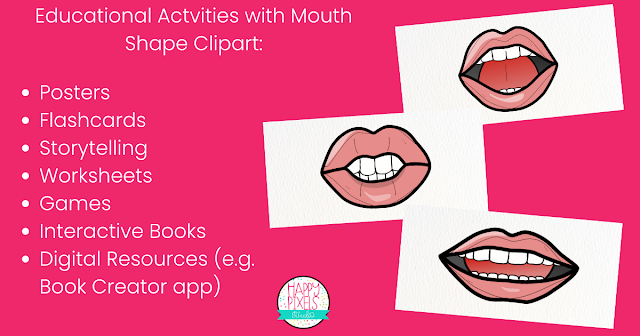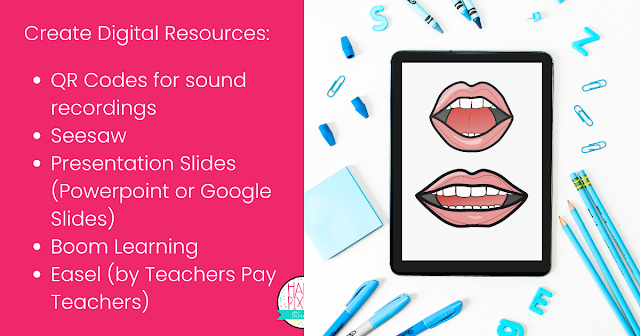INSIDE: How I went from bland, ineffective reading instruction to teaching phonetic reading with fun and foundational phonics reading activities that actually got my students to read. My first step: using mouth models and images.
My young students were making silly faces. They opened their mouths wide, in exaggerated yawns, stuck out their tongues while trying to touch their noses, waggled their tongue back and forth, all while tilting their heads to get even better angles to show each other.
And I sat back and let them.
 | |
|
Why?
Because they were exploring the mirrors I had just given them. We were about to start our phonics reading activities and I knew they were dying to explore the new tool I'd given them. We all know that they have to get their sillies out before we can concentrate.
If you're like me, you've likely had times when you've watched your students struggle with reading. You've been taught to use balanced reading and you've dutifuly organized reading workshops. Children will naturally learn to read when given lots of opportunities, right?
How quickly we found this to be wrong.
Finally, we are going back to the fundamentals.
Phonics.

Colourful Alphabet Image from M. Patel
Teaching phonetic reading forms the foundation of early literacy development, enabling young learners to grasp the intricate connections between sounds and letters.
As educators, finding engaging and effective ways to teach phonics can significantly impact a child's reading and writing abilities.
One innovative tool that can transform phonics lessons is the use of mouth shapes. It begins with exploring our math shapes through modelling and students watching their own mouths change shapes as they make sounds.
Eventually teachers can scaffold that learning into using simple mouth shapes images in their lessons (although it's still fun to get out those mirrors every now and then!)
 |
| Phonics Mouth Shapes Clipart |
How Do You Teach Phonics for Beginners: The Power of Mouth Shapes in Phonics Reading Activities
Mouth shapes images, depicting various positions of the mouth, lips, and tongue, while producing specific phonemes, can be a valuable addition to your toolbox of phonics reading activities.
Here's why:
Visual Aid for Articulation
Visualising how the lips and tongue move during speech sounds can aid in proper articulation. Mouth images allows students to see exactly how their lips and tongue should be positioned for different phonemes.
Start by encouraging students to observe their own mouths in a mirror while practicing sounds. This hands-on approach creates a connection between the visual representation and their own physical movements.
Engagement
Colourful and animated images can capture students' attention, making the learning process more engaging and enjoyable. Visuals often help in retaining information better than just auditory instruction. In addition to clipart, consider using videos or animations that showcase real people producing different sounds. This multisensory approach can enhance engagement and understanding.
Clearer Explanation
Teachers can use mouth shapes clipart to explain challenging phonetic concepts. Showing the differences in mouth positions between similar sounds, such as 'p' and 'b', becomes easier with visual aids.
Inclusion
Mouth shapes clipart can be particularly helpful for English language learners and students with speech difficulties, as it provides a non-threatening way to practice and imitate sounds. Another inclusive approach is to invite a speech-language pathologist to collaborate with your class. They can provide live demonstrations of mouth shapes and articulation techniques, creating a richer learning experience.
 |
| Phonics Reading Activities with Mouth Images |
Ideas for Utilizing Mouth Shapes Clipart in Phonics Reading Activities
Phonics Posters
Create a series of phonics posters with labelled mouth shapes for each phoneme. Hang them around the classroom for easy reference and reinforcement. Supplement these posters with actual mirrors placed strategically in the classroom. This allows students to compare their own mouth shapes with the illustrations.
Flashcards
Develop flashcards featuring both the letter and its corresponding mouth shape. Use these during small group activities or individual practice. Consider incorporating a "guess the sound" game where students use the flashcards to imitate mouth shapes and their corresponding sounds.
Storytelling
Incorporate mouth shapes clipart into storytelling sessions. As you read a story aloud, emphasise the relevant mouth shapes, helping children connect the sounds to the visuals.
Speech-Language Pathologists (SLPs)
SLPs can use mouth shapes clipart to guide articulation therapy. The visuals can assist in illustrating correct mouth placement and aiding children with speech disorders. Collaborate with SLPs to create a resource package that combines their expertise with your phonics instruction, providing a holistic learning experience.
 |
| Vowels Mouth Shapes by Happy Pixels Studio |
Create Your Own Resources
Printable Worksheets
Design printable worksheets that challenge students to identify the correct mouth shapes for different phonemes. These worksheets can feature exercises where students circle the correct mouth shape for a given phoneme, promoting reinforcement and practice.
Bundle these worksheets by phoneme groups or levels. Include a section for students to draw their own mouth shapes, encouraging self-awareness.
Designing Dynamic Worksheets
Phoneme Exploration
Craft worksheets that focus on specific phonemes or sound pairs. For instance, create a worksheet dedicated to differentiating between the 's' and 'z' sounds. Include illustrations of the respective mouth shapes and encourage students to mark the correct sound for each visual.
Articulation Challenge
Develop worksheets that challenge students to identify the correct mouth shape for a given sound. Provide a variety of mouth shape options and ask students to circle or colour the correct one. For added engagement, include a short sentence or word for each sound to put their knowledge into practice.
Matching Activities
Create interactive matching worksheets where students pair the correct letter with its corresponding mouth shape. This activity not only reinforces their phonics skills but also enhances their fine motor skills as they connect the dots or lines.
Enhancing Engagement
Colour and Visuals
Ensure that your worksheets are visually appealing by using vibrant colours for both the mouth shapes and the accompanying letters or words. This draws students' attention and makes learning a more enjoyable experience.
Interactive Elements
Incorporate interactive elements, such as flaps that reveal mouth shapes when lifted or tabs that slide to match the correct sound. These interactive features add an element of surprise and engagement to the worksheets.
Progressive Difficulty
Create a series of worksheets that gradually increase in difficulty. Start with basic phonemes and mouth shapes, and then progressively introduce more challenging sounds. This scaffolded approach helps students build confidence as they master each level.
 |
| Create Digital Resources with Mouth Images |
Digital Resources
Sound Recording
Integrate technology by designing worksheets that include QR codes linked to sound recordings. Students can listen to the sounds and then identify the matching mouth shapes. This auditory component adds an extra layer of sensory learning.
Interactive Games
Design interactive games where students match phonemes to their corresponding mouth shapes. This can be done digitally or as hands-on activities. To add another layer of engagement, include a component where students mimic the mouth shapes while playing the game.
Craft interactive digital downloads that can be accessed on computers, tablets, or interactive whiteboards. These resources could include clickable mouth shapes that provide immediate feedback, enhancing engagement and understanding. Consider adding a feature where students can record themselves attempting different sounds, creating a personalized learning journey. Personally, I love to make books in the Book Creator app.
Creating Resources for Sale
As creative and knowledgeable educators, you can turn this creative approach into a business opportunity by developing and selling your resources.
Educational Materials
Compile a comprehensive resource pack that includes printable worksheets, posters, flashcards, and interactive activities. Organize these materials by phoneme families or difficulty levels, catering to educators seeking a well-rounded phonics teaching package. Market these packs to fellow educators looking for innovative teaching tools. To expand your offerings, collaborate with artists or graphic designers to create a visually appealing resource package.
Professional Development Workshops
Share your expertise by offering workshops or webinars that guide fellow educators, both in-classroom teachers and SLPs, on how to effectively integrate mouth shapes clipart into their instruction. These sessions can focus on practical strategies, activity ideas, and the benefits of visual aids in phonics teaching. Consider inviting guest speakers, such as experts in phonetics or child development, to provide a well-rounded perspective.
 |
| Share your Expertise: Teaching Phonetic Reading |
Mouth Shapes Clipart in Your Classroom
In a world where visual aids are increasingly crucial for effective teaching, mouth shapes clipart can revolutionize the way phonics is taught.
Whether you're a classroom teacher, speech-language pathologist, or an educational resource creator, incorporating these visual tools can elevate the learning experience and contribute to the growth of young learners' phonemic awareness.
Have fun teaching phonics to your young, beginning readers!
P.S. You can get your own mouth images, for classroom or commercial use, here:
 |
| Mouth Shapes Bundle: Vowels and Consonants (including black and white images) |

No comments
Post a Comment